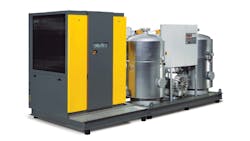The Ins and Outs of Hybrid Refrigerated/Desiccant Compressed Air Dryers
For those relatively few, but generally large compressed air applications that need extremely dry air (down to -40°F), there are several types of desiccant dryers to do the job. In many cases, the most effective and least costly to operate will be a hybrid dryer system.
The hybrid solution includes both refrigerated and desiccant systems in series. Refrigeration will typically remove 85 to 88% of the total amount of water, and the desiccant dryer is challenged with only the remaining 12 to 15% of the total water removal. As refrigeration is comparatively a very inexpensive method for dehydrating compressed air, the energy to produce a dew point of -40°F in a compressed air stream is significantly reduced when the air is first routed through a refrigeration system before being treated by a desiccant dryer.
Whether the extra low dew points are needed year-round or only seasonally, this combination achieves better dew point stability and significantly reduces both operating and maintenance costs compared to other dryer types equally capable of producing dew points as low as -40°F.
The combination system permits the refrigerated dryer to be operated independently. This is advantageous because many systems with desiccant dryers only need them during cooler months. The majority of compressed air applications simply require the water vapor remaining in the air after treatment to remain in the vapor state, and a refrigerated dryer provides adequate drying during warm weather periods.
If the desiccant dryer is only needed during cooler months, additional operating and maintenance cost savings are realized.
